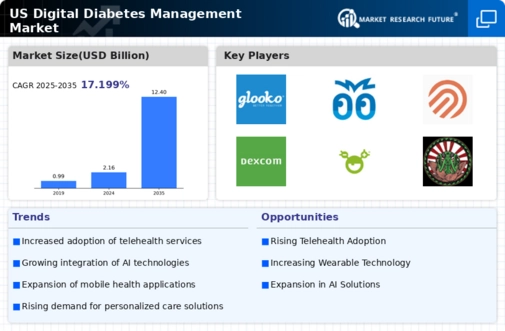Increasing Prevalence of Diabetes
The rising incidence of diabetes in the US is a primary driver for the digital diabetes-management market. According to the Centers for Disease Control and Prevention (CDC), approximately 34.2 million Americans, or 10.5% of the population, have diabetes. This alarming statistic underscores the urgent need for effective management solutions. As the number of diagnosed cases continues to grow, the demand for digital tools that facilitate monitoring and management of diabetes is likely to increase. The digital diabetes-management market is expected to expand as healthcare providers and patients seek innovative solutions to improve health outcomes and reduce complications associated with diabetes. This trend suggests a robust market potential for digital health technologies that can assist in daily management and provide real-time data to both patients and healthcare professionals.
Technological Advancements in Health Monitoring
Technological innovations play a crucial role in shaping the digital diabetes-management market. The development of advanced health monitoring devices, such as continuous glucose monitors (CGMs) and insulin delivery systems, has transformed diabetes care. These devices enable patients to track their glucose levels in real-time, leading to more informed decision-making regarding their health. The integration of artificial intelligence (AI) and machine learning into these technologies further enhances their capabilities, allowing for personalized treatment plans. As these technologies become more accessible and affordable, the digital diabetes-management market is poised for growth. The increasing adoption of smart devices and applications that facilitate data sharing between patients and healthcare providers indicates a shift towards more proactive diabetes management.
Growing Demand for Personalized Healthcare Solutions
The digital diabetes-management market is significantly influenced by the increasing demand for personalized healthcare solutions. Patients are increasingly seeking tailored approaches to their diabetes management, which can be facilitated through digital platforms. These platforms often utilize data analytics to provide customized recommendations based on individual health metrics. The trend towards personalized medicine is supported by a growing body of evidence suggesting that individualized treatment plans can lead to better health outcomes. As healthcare systems in the US continue to evolve, the integration of personalized digital solutions is likely to become a standard practice. This shift not only enhances patient engagement but also fosters a more collaborative relationship between patients and healthcare providers, driving growth in the digital diabetes-management market.
Rising Healthcare Costs and Focus on Cost-Effectiveness
The escalating costs associated with diabetes care are a significant driver for the digital diabetes-management market. The American Diabetes Association estimates that the total cost of diagnosed diabetes in the US was $327 billion in 2017, a figure that has likely increased. As healthcare costs continue to rise, both patients and providers are seeking cost-effective solutions to manage diabetes. Digital tools that offer remote monitoring and telehealth services can reduce the need for frequent in-person visits, thereby lowering overall healthcare expenses. This focus on cost-effectiveness is likely to propel the adoption of digital diabetes-management solutions, as they provide a means to improve care while managing financial burdens. The market is expected to benefit from this trend as stakeholders prioritize solutions that deliver value without compromising quality.
Increased Awareness and Education on Diabetes Management
There is a growing awareness and education regarding diabetes management among the US population, which serves as a catalyst for the digital diabetes-management market. Public health campaigns and educational initiatives have significantly improved understanding of diabetes and its complications. As individuals become more informed about the importance of effective management, they are more likely to seek out digital solutions that can assist them in their daily lives. This heightened awareness is fostering a culture of proactive health management, where patients actively engage with digital tools to monitor their condition. Consequently, the digital diabetes-management market is likely to experience growth as more individuals recognize the benefits of utilizing technology in their diabetes care.























Leave a Comment